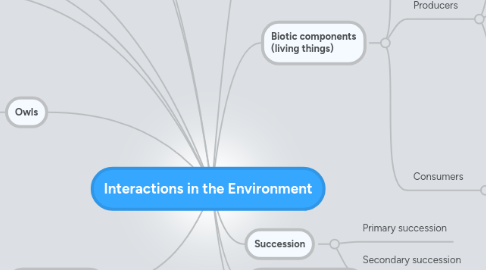Interactions in the Environment
by Brad Stephens


1. Food chains
2. Food webs
3. Energy pyramids
4. Cycling of matter
4.1. producer to consumer to decomposer and back to producer again!
4.2. Oxygen
4.3. Carbon
5. Owls
5.1. Habitat
5.2. Prey
5.2.1. Owl pellets
5.2.1.1. What they are
5.2.1.2. How they are made and why
5.3. Behaviour
5.3.1. Night hunters
5.4. Physical features
5.4.1. Digestion
5.4.2. Beak
5.4.3. Feathers/wings
5.4.4. Facial disk
5.4.4.1. Eyesight
5.4.4.2. Hearing
5.4.5. Talons/claws
6. Bioinvasion
6.1. Sea Lamprey case study
7. Competition
8. Sustainability
9. Abiotic components (non-living things)
9.1. Air
9.2. Water
9.3. Rock
9.4. Soil
9.5. Sunlight
10. Biotic components (living things)
10.1. Five basic needs
10.1.1. Food
10.1.2. Water
10.1.3. Oxygen
10.1.4. Energy
10.1.5. Suitable habitat
10.2. Producers
10.2.1. Plants
10.2.2. Most algae, a few bacteria
10.2.3. Make their own food
10.2.3.1. Photosynthesis
10.2.3.1.1. Sunlight + Carbon dioxide + Water → Food (glucose) + Oxygen
10.3. Consumers
10.3.1. Animals
10.3.1.1. Respiration
10.3.1.1.1. Food (glucose) + Oxygen → Energy + Carbon Dioxide + Water
10.3.2. Fungi, most bacteria
10.3.3. Basic types
10.3.3.1. Herbivores
10.3.3.2. Omnivores
10.3.3.3. Carnivores
10.3.4. Special types
10.3.4.1. Scavengers
10.3.4.2. Decomposers
